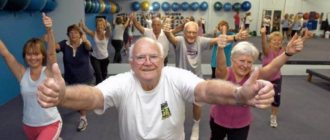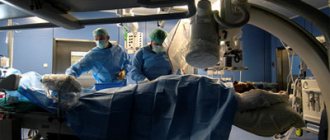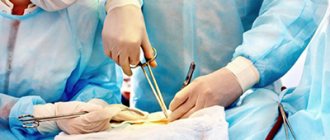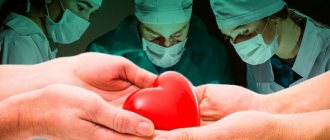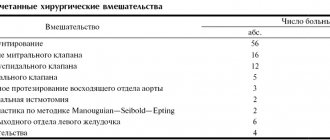Is a bandage needed after surgery?
The postoperative effect of the bandage lies in the external pressure that the Intex elastic belt exerts on the abdominal area after surgery and childbirth. Wearing a bandage after surgery : - Reduces the load on the postoperative wound, preventing the sutures from coming apart. — Improves blood circulation in the area of the postoperative wound, accelerating the formation of fibrin fibers. A durable scar is formed, eliminating the formation of a hernia - protrusion of internal organs through the scar area. — Provides external pressure on the postoperative suture, orienting fibrin fibers in the correct direction. This prevents the appearance of overgrown keloid scars. – Supports abdominal muscles weakened after surgery, helping the patient maintain a slim figure. — Fix internal organs in the correct position. This reduces the risk of the kidneys descending into the pelvic area.
Indications
CABG is an operation that is primarily required for patients with severe angina that is resistant to drug therapy. In addition, surgical treatment may be recommended in the absence of symptoms. There is silent myocardial ischemia, which is no less dangerous. It is not felt by the patient, but can be diagnosed using ECG and Holter monitoring.
Indications for CABG can also be determined using coronary angiography. This is an x-ray test in which contrast is injected into the arteries of the heart. The main cause of mortality from coronary disease is atherosclerosis and disruption of the integrity of the atherosclerotic plaque. The blood vessel is torn, and a blood clot forms at the site of damage. It clogs the coronary artery, resulting in myocardial infarction.
Coronary angiography allows you to identify large obstacles to blood flow (atherosclerotic plaques) and assess the risk of acute cardiovascular events. A high degree of coronary artery disease requires cardiac CABG.
Based on the results of coronary angiography, the main indications for CABG are:
- Narrowing of the lumen of any coronary artery by 75% or more
- Reduction in the lumen of the left coronary artery trunk by 50% or more
The location of stenosis (impaired patency) of the coronary arteries is also assessed. The more proximal it is (closer to the heart), the worse the blood supply to the myocardium. CABG surgery on the heart will be most successful if normal blood circulation is observed beyond the narrowing.
Find a specialized clinic
How to choose a postoperative abdominal bandage?
What postoperative bandages are considered high quality? The postoperative bandage should fully relieve the postoperative suture and support the abdominal muscles, be comfortable to wear and not cause allergies. The postoperative Russian Intex bandage fits tightly to the abdomen, easing the load on the scar and abdominal muscles. The belt is made of durable, non-allergenic materials (latex, polyester, polypropylene - can cause allergic reactions of an individual nature), therefore it has a fine texture that allows you to wear the belt discreetly under clothing.
Physical rehabilitation after reconstruction of the anterior cruciate ligament of the knee joint
The anterior cruciate ligament is one of the important ligaments that provides stability to the knee joint. It connects the posterior part of the intercondylar surface of the lateral condyle of the femur with the anterior part of the articular surface of the upper end of the tibia.
The ligament limits excessive anterior displacement of the tibia relative to the thigh. In addition, the nerve endings located in it, in response to load and changes in the position of the joint, give signals to the muscles that stabilize the knee.
Thus, a strong anterior cruciate ligament prevents subluxations and instability in the knee when walking, running, jumping, dancing, i.e. in situations where a sudden change in direction of movement occurs.
Anterior cruciate ligament tears can occur when the knee suddenly twists, hyperextends, or bends while running, landing from a jump, or from a blow to the knee or shin. The most common circumstances of injury are sports games
It should be understood that engraftment of the graft in the knee joint occurs within 12 weeks from the date of surgery. During this period, the new ligament is the weakest and most vulnerable, so care should be taken to exclude the possibility of excessive stress on the ligament. You cannot run, dance, jump, land from a height on the operated leg, squat deeply, perform twisting movements in the knee, stumble and twist your leg, or kneel.
In this regard, the recovery period for this injury is long and is divided into several stages:
POSTOPERATIVE PERIOD
The first week after surgery - in the hospital
The goal is to prevent postoperative thromboembolic complications, reduce postoperative pain and swelling, and restore muscle tone.
Physical exercise:
- active extension-flexion movements of the feet (toes towards you - toes away from you) 30 times every 2 hours during the day;
- voluntary tension of the anterior and posterior thigh muscles for 5 seconds 10-15 times every 2 hours during the day;
Walking
- using crutches and indicating support on the operated leg (place the foot on the floor). Duration: 5-15 minutes 4-5 times a day. During the first 2-3 days after surgery, walk only when necessary (to and from the toilet).
- Supporting load: lean on a straightened leg with a load equal to the weight of the limb (support on the heel, not on the toe). The load should not cause pain in the knee joint.
Forbidden:
- walk with support on a bent leg;
- active extension of the lower leg at the knee joint in the range from 0° to 40°.
Second week after surgery
The goal is to prevent postoperative thromboembolic complications, reduce postoperative pain and swelling, restore mobility in the knee joint (extension - flexion within the range of pain no more than 60°), improve the weight-bearing ability of the operated leg.
Physical exercise:
- Active extension-flexion movements of the feet (toes towards you - socks away from you) 30 times 3-4 times a day.
- Voluntary tension of the anterior and posterior thigh muscles for 5 seconds 10-15 times 3-4 times a day.
- Active flexion and passive extension of the knee joint until pain is felt 10-15 times 1-2 times a day. For patients who have had ligament plastic surgery using the hamstrings, perform the exercise without strong tension in the posterior thigh muscles, helping yourself with your hands to grab the lower third of the thigh.
- Raising a straight leg with weight in a lying or standing position 10-15 times 2-3 times a day.
- Restoring mobility (mobilization) of the patella: move the kneecap with your hand up and down, outward and inward - 10-15 times 3 times a day.
- Full passive extension of the knee joint Position - sitting on a chair, the operated leg lies on a second chair. Place a weight weighing 0.5 kg on the lower third of the thigh. Relax your muscles, trying to fully straighten your leg at the knee. Hold the load for 10 minutes. Repeat styling 2 times a day.
Walking:
With the help of crutches. Duration: 10-15 minutes 4-5 times a day.
Support load: lean on a straight leg with a load of 25-50% of body weight.
Forbidden:
- walk with support on a bent leg;
- active (muscle strength) extension of the knee ranging from 0° to 40°.
REHABILITATION PERIOD (3-5 weeks after surgery)
The goal is to improve the mobility of the knee joint ranging from full extension to flexion at an angle of about 90″, restore the supportability of the leg, and increase the tone and elasticity of the thigh muscles.
Physical exercise:
- Voluntary tension of the anterior and posterior thigh muscles for 5 seconds 10-15 times 3-4 times a day.
- Active flexion and passive extension of the knee joint 10-15 times 2-3 times a day.
- Raising and holding a straight leg suspended in a lying position 10 times 3 times a day.
- Active bending of the leg at the knee from a lying position on the stomach 10-15 times 2-3 times a day. For patients who have had ligament plastic surgery using the hamstrings, perform the exercise from the 5th-6th week.
- Restoring mobility (mobilization) of the patella: move the kneecap with your hand up and down, outwards and inwards - 10-15 times 3 times a day.
- Full passive extension of the knee joint with placement of a weight weighing 1 kg on the anterior part of the knee joint for 10 minutes, 2 times a day. The exercise is performed at the end of the training cycle.
Walking:
From the 4th week, walking without additional support.
Forbidden:
- Walk with support on a bent leg;
- Active (muscle strength) extension of the knee ranging from 0 to 40°.
6-7 weeks after surgery
The goal is to restore mobility in the knee joint, restore tone, elasticity and increase the strength of the thigh muscles, restore leg support and walking skills, and restore everyday ability to work.
Physical exercise:
- Restoring mobility (mobilization) of the patella: move the kneecap with your hand up and down, outwards and inwards - 10-15 times 3 times a day.
- Bend the leg at the knee joint using manual traction using a loop of a towel or rubber bandage 10-15 times 2-3 times a day.
- Leg abduction in a lateral position with external resistance 10-15 times 2-3 times a day.
- Active bending of the leg at the knee joint while lying on the stomach with external resistance 10-15 times 2-3 times a day.
- Bringing the leg in a position lying on its side with external resistance 10-15 times 2-3 times a day.
- Raising a straight leg forward in a standing position with external resistance 10-15 times 2-3 times a day.
Walking
No additional support. Duration: 20-40 minutes 4-5 times a day.
Forbidden:
Walk with support on a bent leg;
Functional period (8-12 weeks after surgery)
The goal is to restore physiological mobility of the knee joint, restore tone, elasticity and increase strength of the thigh muscles, improve muscle balance and coordination of movements, restore daily activity, return to office and light physical work.
Physical exercise:
- Perform all of the above exercises.
- Exercises to restore coordination of the muscles of the operated leg and maintain body balance on an unstable support. Balance training should begin with simple exercises with a rehabilitator's belay or self-belay at the wall: turns, bends, swaying the body on two bent legs with eyes open and closed. Use a hard floor as a support at first, and only as you gain confidence in your leg, switch to unstable supports (mattress, sofa cushion, gymnastics mat, special inflatable pillows or swinging platforms).
- Half squats on one leg from 10° to 60′ 10-15 times 1-2 approaches.
- Exercise on an exercise bike for 10-30 minutes a day.
Control of loads and intensity of exercise: swelling and pain in the joint should not be constant. If knee swelling does not go away after rest and in the morning, then you need to stop exercising for 2-3 days. If swelling persists after rest, you should see a traumatologist.
Walking without restrictions.
TRAINING PERIOD (13-30 weeks after surgery)
The goal is to restore normal mobility and stability in the knee joint, muscle strength and endurance, muscle control and coordination of complex movements, and restore the ability to perform physical labor and play sports (for athletes).
3. Walk without restrictions.
4. Exercise:
- Performing a set of exercises similar to the period of 8-12 weeks.
- Training to maintain body balance on an unstable support
- Exercise on an exercise bike for 30 minutes 1-2 times a day,
- Fast walking on a treadmill.
- Exercises on weight machines aimed at strengthening the strength of the posterior and anterior thigh muscles and other muscle groups - 2 times a week. Please note that until 6 months after surgery you should not train the anterior thigh muscles on a machine with a block; premature force load on the kneecap can lead to damage to the patellar cartilage.
- Jogging outside - from 16-18 weeks.
- Squats from 0′ to 90* - from 18-20 weeks.
- Squats from 0° to 90° with weight, side steps, jumping, exercises with a skipping rope, snake running and acceleration - from the 20-24th week.
Forbidden:
For up to 6 months from the date of surgery, perform strength exercises for the anterior thigh muscles on a machine with a block (i.e. extension)
The beginning of general and special sports training for the coordination of complex movements, strength, speed and endurance of muscles under the guidance and control of the coach and team physiotherapist - from the 24-25th week after surgery.
How to choose a postoperative bandage?
In order to select an Intex bandage, you need to take two measurements (in cm): waist circumference and hip circumference. Then you need to compare the measurements with the tabulated intervals. Let's assume that your waist is 76 cm and your hips are 105 cm. These measurements fit into the intervals corresponding to size 3 (M).
The width of the postoperative bandage depends on the location of the scar. A belt with a width of 22 cm is suitable for people below average height, 30 cm - for people above average height. By average we mean a height of 175 cm for a man, 165 cm for a woman.
Where is the best place to do CABG?
Coronary artery bypass surgery is performed all over the world. Many residents of the CIS undergo CABG in Moscow. Often, residents of developing countries seek to travel abroad for surgery. Because it is very dangerous and requires a long recovery. A better-quality operation provides better treatment results and a less painful rehabilitation period.
Residents of many countries go to the States for CABG surgery. The medicine there is really high quality, but very expensive. It is cheaper to do CABG in Israel. We recommend Germany. This is the “golden mean” - German clinics are able to provide the same high quality of medical services as the United States, but it is easier to come here for treatment, and the services of doctors are cheaper.
The main advantages of coronary artery bypass surgery in Germany:
- Surgery is performed on a beating heart if possible given the clinical situation
- The best doctors work in Germany - they come here from all over the world to practice medicine. And when performing CABG, the qualifications of the cardiac surgeon play a significant role
- German clinics are equipped with the latest technology
- After the operation, the person is provided with high-quality care and medicinal support, which improves the tolerability of the early postoperative period
- The opportunity to undergo high-quality rehabilitation, which will return a person to his former lifestyle and restore his ability to work
Safe and effective aortic surgery can be performed at the Helios Klinik Krefeld, a medical center of maximum care, continuously collaborating with leading universities and research centers around the world. The Department of Adult and Pediatric Cardiac Surgery, under the direction of Prof. Dr. med. Jürgen Ennker, has a number of its own developments in the field of surgical interventions on the thoracic and abdominal aorta. These are coronary artery bypass grafting using minimal extracorporeal circulation (a special heart-lung machine is used), coronary artery bypass grafting on a beating heart, and minimally invasive direct coronary artery bypass grafting. The department also uses hybrid endoprostheses of the thoracic and abdominal aorta, and performs classical reconstructive interventions with the installation of self-expanding stents. At the same time, the department’s specialists perform both primary and more complex revision interventions on patients of all ages.
Treatment in Germany can be organized for you by ]Booking Health[/anchor]. We have been working in the medical tourism market for a long time, so we can choose the best clinic for you. You will be treated by the most reputable German specialists.
Thanks to our help, you can save up to 70% of the total costs of treatment and its organization. We have direct contracts with all major clinics in Germany. For treatment you do not have to take out insurance for foreign patients. You will receive Booking Health insurance, which will cover all unexpected medical expenses during the treatment period and for 4 years after it.
Contact Booking Health
Instructions for choosing a corset
Step 1. First you need to decide what type of corset to buy. You need to take into account its functionality and rigidity. Usually the choice is made depending on the indications.
Decide on the type of corset
Step 2. You should study the corset market and find out what models are on sale, which one is better to buy, and what they are made of. At the same time, the budget is immediately taken into account.
Check out the available models
Step 3. Then you need to familiarize yourself with the corset fastening systems and choose the one that seems most comfortable.
